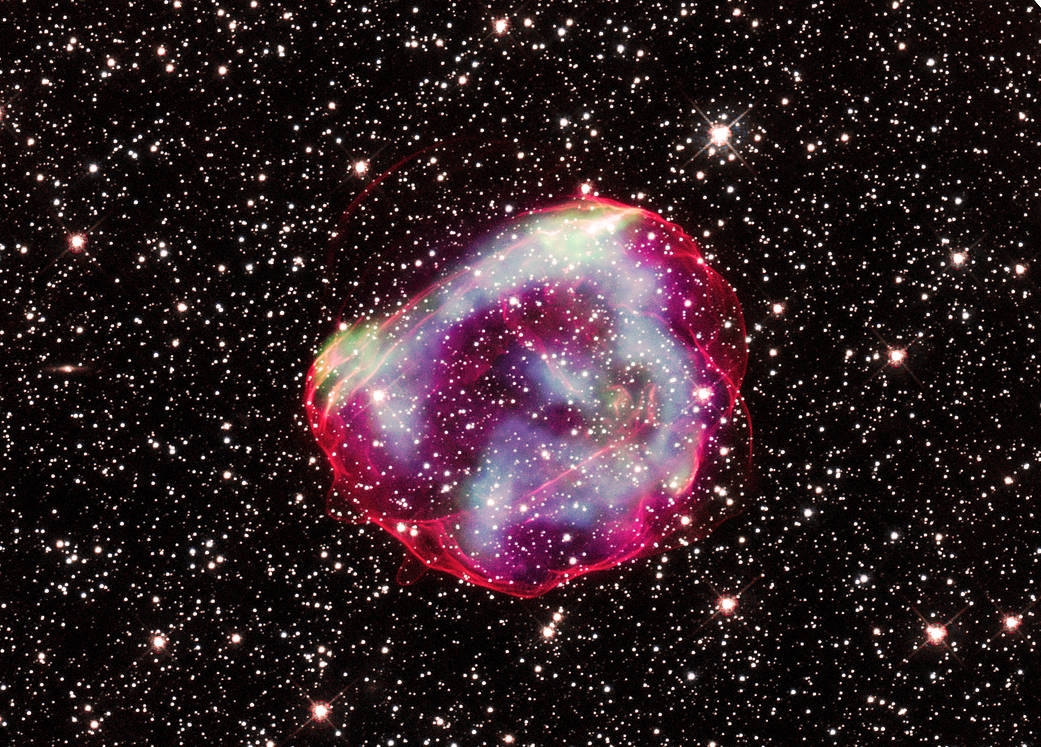How to determine the timeline of a star-death, answered

While it is often difficult to determine the timeline of the star-death, astronomers have now found enough clues to do the same by studying the remnants of a supernova in a neighboring galaxy using NASA telescopes .
The supernova remnant is known as SNR 0519-69.0 (abbreviated SNR 0519) and is located in the Large Magellanic Cloud, roughly 160,000 light-years from Earth. It is composed of the remnants of a white dwarf star that blew up after reaching a critical mass by either being pulled its matter from a companion star or merging with another white dwarf. The star was later destroyed by a thermonuclear explosion.
A Type Ia supernova is used by astronomers for a wide range of scientific studies, including studies of thermonuclear explosions and measurements of the distances between galaxies over billions of light-years.
This composite image includes optical and X-ray data from NASA’s Hubble Space Telescope and Chandra X-ray Observatory. Low, medium, and high energy X-rays from SNR 0519 are shown in green, blue, and purple, with some of these colors overlapping to appear white. Optical data shows the stars surrounding the remnant in white and the remnant’s perimeter in red.
They estimated the date of the star in SNR 0519’s explosion and learned more about the environment the supernova happened in by assembling information from Chandra, Hubble, and NASA’s retired Spitzer Space Telescope. Astronomers were able to study stellar evolution that has occured since and determine its beginning from the data.
Also Read: Rare superluminous supernova found: Researchers
Using Hubble images from 2010, 2011, and 2020 to measure the speeds of material in the blast wave from the explosion, they found that the velocity ranges from about 3.8 million to 5.5 million miles (9 million kilometers) per hour. If the speed was toward the upper end of those estimated speeds, the astronomers determined that light from the explosion would have reached Earth about 670 years ago, or during the Hundred Years’ War between England and France and the height of the Ming dynasty in China.
Although it’s likely that the material has slowed down since the first explosion and that it happened more recently than 670 years ago, it’s more likely that the explosion took place. The data from Chandra and Spitzer give hints that this is the case. The slowest-moving material is found to be in the brightest parts of the remnant in X-rays, whereas the fastest-moving material does not emit any X-rays.
These results indicate that a portion of the blast wave might have interacted with the dense gas around the remnant, slowing it down as it moved. Additional Hubble observations may be used by astronomers to determine the precise time that the star should actually die.
An estimated 20 supernova explosions have happened within 300 Parsec [1 Parsec = 3.26156 light years] of the Earth over the last 11 million years. Type II supernova explosions are expected to occur in active star-forming regions, with 12 such OB associations being located within 650 pc of the Earth. Eta Carinae, located nearly 7,500 light-years away, is the closest supernova to earth.
Also Read: Astronomers observed a bright white dwarf, a ‘zombie star’
At present, there are six near-Earth supernova candidates within 300 Parsec .
The closest candidate for a supernova progenitor is the star IK Pegasi B. About 150 light years from our sun and solar system, it is a part of a binary star system. IK Pegasi A, the system’s main star, is a normal main-sequence star, much like the sun.
To survive a supernova, Earth would have to be at least 50 light-years away from the exploding star.
These results were published in The Astrophysical Journal‘s August issue.
Image credit: X-ray: NASA/CXC/GSFC/B. J. Williams et al.; Optical: NASA/ESA/STScI
Auto Amazon Links: No products found.


